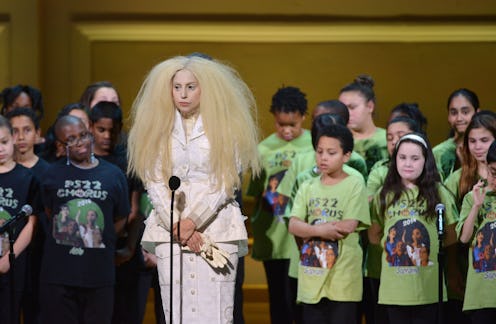Entertainment
Lady Gaga Hates Photoshop
Lady Gaga loves a bold statement, and the singer made several of them last night at Glamour 's Women of the Year Awards. From a double-take-inducing ensemble to an impassioned speech on the evils of Photoshop, Gaga took the event as an occasion to reiterate why, exactly, she loves to bend the confines of fashion, and in doing so, encouraged viewers to remember why imperfection is so darn important.
The performer arrived at the awards ceremony outfitted in a pearl-emblazoned Thom Browne skirt suit, white gloves and towering custom-designed platform sandals, but her hair and makeup was the real shocker of the look. With a teased, powdered, white-blond wig, white eyeliner, and lurid spots of blush on her cheeks, Gaga could easily have been mistaken for an extra in Amadeus. While onstage accepting her Woman of the Year award, Gaga said "I don't even look like this". We're glad she admitted it.
One of the stranger moments of Gaga's acceptance speech, however, was her decision to criticize Glamour for Photoshopping her December cover and the corresponding photo spread, reminding viewers that she values peculiarity over perfection. Gaga took the award ceremony as an opportunity to reiterate her famous "Born This Way" credo in reference to the December issue, saying "I do not look like this when I wake up in the morning." In addition to a seemingly slenderized nose and a more angular frame in the article's accompanying photos, Gaga said "I felt my skin looked too perfect. I felt my hair looked too soft."
Airbrushing is certainly a hot button issue for fashion publications and readers alike, and Gaga's statements are in keeping with her trailblazing, chameleon-like approach to fashion. To date, Gaga's most visually conventional beauty look appeared in her early work including music videos for 2008 dance hits "Poker Face" and "Just Dance", in which she dons a pin straight blond hairdo, heavy black eyeliner, and thick lashes. The look hearkens back to '90s pop princesses from Baby Spice to Britney Spears, whose appearances were meant to look sleek, perfect, and soft in an attempt to sell albums. Gaga's ode to the ordinary was short lived, and she returned to rejecting style standards at every possible opportunity.
After the The Fame achieved notoriety, Gaga immediately dove into more challenging material both musically and stylistically, including "Bad Romance" and "Telephone," and effectively ditched any associations she may have had to a traditional pop icon image. Gaga took the advent of fame to encourage her Little Monsters to both celebrate their innate beauty and express it, instead of viewing their individuality as a misfortune. Gaga has since run the gamut with her fashion choices, utilizing her stardom to experiment with avant-garde couture looks and technologically advanced designs. Recent winners include a mustache and fur coat ensemble in Berlin and a black, textured Philip Treacy hat which looks like it obstructs vision in addition to sunlight. From the looks of it, the only style statement Gaga isn't willing to embrace is conformity.
Gaga's problem with the Glamour cover, therefore, has less to do with conventional beauty and more to do with the fashion industry's means of imposing conformity. Gaga once again illuminates the disparity between magazines who claim to celebrate unique style, and their digital enhancement of even the most prolific tastemakers to fit an ideal of beauty. The one consistent message we can glean from Gaga's many manifestations is that style has no single definition, and as such, we should "fight back against the forces that say you have to be beautiful," especially when beautiful means erasing imperfections. Glamour's transgression, it seems, was attempting to refine the image of a woman who pledges allegiance to her outré and individualistic style, flaws and all.
